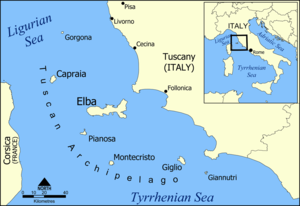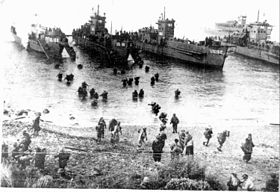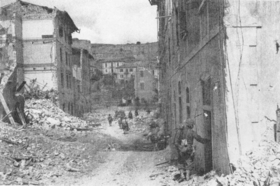- Invasion of Elba
-
Invasion of Elba Part of Italian Campaign 
Elba between Corsica and ItalyDate 17 June 1944 Location Elba, Italy Result Allied victory Territorial
changesElba captured Belligerents  United Kingdom
United Kingdom
 France
France
 US
US Nazi Germany
Nazi GermanyCommanders and leaders Naval
 Rear Admiral Thomas Hope Troubridge
Rear Admiral Thomas Hope Troubridge
Land
 General Jean de Lattre de Tassigny
General Jean de Lattre de Tassigny General Gall
General GallUnits involved British
Naval Force N
Royal Navy Commandos
26 Vickers Wellington
French
9th Colonial Infantry Division
Bataillon de Choc Commando
2nd Groupe de Tabors Marocains
United States
Landing Craft
PT boats
87th Fighter Wing
57th Bombardment Wingtwo infantry battalions
several coastal artillery batteries
totalling 60 guns of medium and heavy calibreCasualties and losses British
38 dead and nine wounded
French
252 dead and 635 wounded
(land casualties only, naval casualties not known)500 dead and 1,995 prisoners of war The Invasion of Elba, codenamed Operation Brassard, was part of the Italian Campaign in the Second World War.
The invasion was carried out by Free French Forces supported by British and American ships and aircraft. It came as a complete surprise to the German garrison although it had been reinforced for just such a possibility. The defenders resisted for two days before being given permission to withdraw to the mainland.
Contents
Background
The Allied 15th Army Group—under the command of General Sir Harold Alexander—captured Rome on 4 June 1944 and forced the German 14th and 10th Armies to withdraw into Northern Italy.[1] This success was followed by orders for the invasion of southern France, Operation Dragoon. The 15th Army Group were asked to supply the majority of the troops for the landings. This reduced the U.S. 5th Army to five divisions. The whole of the 15th Army Group now only consisted of 18 divisions, and the reduction in strength put on hold any plans Alexander had of reaching the Gothic Line by August 1944.[1]
One operation they could still carry out was the invasion of Elba (Operation Brassard), which had initially been scheduled for 25 May, at the same time as Operation Diadem.[2] The landings had then been postponed because of the shortage of support aircraft and to allow the inexperienced French troops more time for training.[2][3] The objectives of the invasion were to prevent the Germans using the island as a forward outpost and to provide a gun position for Allied artillery to interdict traffic on the Piombino canal.[1] It is not known if the Germans were aware of the Allied plans, but Adolf Hitler "attached great importance to holding Elba as long as possible." On 12 June, the German commander in Italy—Field Marshal Albert Kesselring—was informed that "Elba must be defended to the last man and the last cartridge." On 14 June, German reinforcements started to arrive on Elba from Pianosa. The decision to reinforce Elba was not known to the Allies who believed the naval activity between the island and the mainland was in fact an evacuation.[4]
Planning
The naval commander for the operation was Rear-Admiral Thomas Hope Troubridge of the Royal Navy. He was in command of Force N, which would be responsible for landing the assault division. The division chosen for the assault was the French 9th Colonial Infantry Division, comprising the 4th and 13th Regiments Senegalese Tirailleurs, the Bataillion de Choc Commando, a Moroccan Goumier battalion and 200 mules.[4][5] Because of the shallow waters large naval and transport ships could not be used. The only naval gunfire support would be provided by Landing Craft "Hedgehogs" and the "Insect"-class gunboats HMS Aphis and Cockchafer.[4]
The naval force would be formed into three groups:
- Group 1 comprised Motor Torpedo Boats and PT boats. They would initially create diversions and land the French Commandos on the northern side of the island. Their objective would be the gun batteries located there.[4]
- Group 2 would comprise five Landing craft infantry and eight Motor Launches each towing a Landing Craft Assault. Their objective was four beaches on the south coast.[4]
- Group 3 comprised the main force, in nine Landing Craft Infantry, four Landing Ship Tank, three Motor Launches towing Landing Craft Support (Medium). The main landings would be on two beaches codenamed Kodak Amber and Kodak Green at 04:00. They would be followed at 04:30 by another 28 Landing craft infantry and after dawn by 40 Landing craft tank, bringing in heavier equipment.[4]
In the briefing immediately prior to the landing, Troubridge said he expected the shore batteries to have been taken out by aerial bombardment and the commandos. He also said the garrison only consisted of about 800 men. Mostly of Polish or other non-German nationalities who were unlikely to put up much resistance.[4]
Invasion
On 16 June, the day before the invasion, German reconnaissance aircraft spotted two flotillas of invasion ships, but thought they were just the normal naval convoys between Naples and Bastia.[6] To preserve the surprise, there was no pre-invasion bombing until the night of 16/17 June, when 26 Vickers Wellingtons bombed Portoferraio and Porto Longone.[7] The 270 ships of the invasion fleet arrived off Elba just after midnight on 17 June,[8] when ships from Group 1 disembarked 87 men from the Bataillion de Choc Commando in rubber dinghys .5 mi (0.4 nmi; 0.8 km) offshore of Cape Enfola. The naval group then started laying a smokescreen to create a diversion. At 03:15, three other boats started laying smoke north of Portoferraio. With the German gun batteries engaging a retreating PT boat, four others made toward Portoferraio to simulate landing craft approaching, firing salvos of rockets and dropping dummies overboard to give the impression of troops wading ashore.[9]
In the south, the main invasion force was approaching the island when, at 03:38, a signal flare was fired and the Germans opened fire on the landing craft. The Royal Navy Commandos of Able 1 and Oboe 3 Commando with Able 2 in reserve landed at 03:50. They approached the beach toward their objective: the heavily-armed German flak ship Köln, which was berthed at Marina di Campo and had a commanding view of both beaches. This made its capture or destruction vital to the landings. The A1 Commando were assigned the task of capturing the ship, while O3 Commando would defend the jetty from any attack by German reinforcements. The two landing craft of the Royal Navy Commandos entered the bay of Marina di Campo and made for the flak ship. They came under heavy fire before one landing craft was hit and ran aground; the landing craft managed to get alongside the flak ship before also being hit by gunfire. The men of A commando quickly captured Köln while O Commando secured the jetty. Both commandos now waited for the French to secure the village.
The LCVPs carrying the French division beached right on time to be met by heavy machine gun and 88 mm (3.46 in) fire. By 07:00, the German defences in the hills above Kodak Amber beach had forced the incoming landing craft to lay smoke and withdraw.[9] The heavy defensive fire forced the follow-up waves of landing craft to divert to Kodak Green beach, which caused some congestion on the beachhead. Delays and German gunfire kept some landing craft off shore until 14:00.[5]
The Royal Navy Commandos—unaware of the diversion to the other beach—had to wait some hours before the French cleared the village and reached them. It was during this time that the Royal Navy Commandos suffered their greatest losses. The commandos were under continuous artillery and small arms fire, which is believed to have set off two demolition charges on the jetty, blowing a 30 ft (9.1 m) hole in the concrete structure. The force of the explosions killed almost all the commandos and their prisoners. It also set fire to Köln and exploded the ammunition stowed on board.
Within two hours of the landings, French commandos had reached the crest of the 1,300 ft (400 m) Monte Tambone Ridge overlooking the landing areas. Portoferraio was taken by the 9th Division on 18 June, and the island was largely secured by the following day. Fighting in the hills between the Germans and the Senegalese colonial infantry was vicious, with the Senegalese employing flamethrowers to clear entrenched German troops.[7][10]
On 19 June, the German commander asked for permission to evacuate what was left of his forces. By the evening on 20 June, they had successfully evacuated 400 men to the mainland.[11]
Aftermath
The invasion of Elba was of doubtful necessity. The advance of the U.S. 5th Army past Grosseto had made the continued occupation of the island by the Germans untenable.[7] The Germans defended Elba with two infantry battalions, fortified coastal areas, and several coastal artillery batteries totalling some 60 guns of medium and heavy calibre. In the fighting for the island, the Germans lost 500 dead, with another 1,995 becoming prisoners of war. French losses were 252 killed or missing, and 635 men wounded, while the British lost 38 killed and nine wounded.[10] General de Tassigny went on to command the French 1st Army in the invasion of southern France. This force fought through Europe to the Austrian border by the end of the war.[12]
Notes
References
- Bimberg, Edward L (1999). The Moroccan Goums: Tribal Warriors in a Modern War. Greenwood Publishing Group. ISBN 0313309132.
- Craven, Wesley Frank (1983). The Army Air Forces in World War II. DIANE Publishing. ISBN 091279903X.
- de Tassigny, Jean de Lattre (1952). The History of the French First Army. George Allen and Unwin Ltd.
- Tomblin, Barbara (2004). With Utmost Spirit: Allied Naval Operations in the Mediterranean, 1942—1945. University Press of Kentucky. ISBN 0813123380.
- Tucker, Spencer (2001). Who's Who in Twentieth Century Warfare. Routledge. ISBN 0415234972.
Categories:- Battles and operations of World War II involving the United Kingdom
- Military operations of World War II involving Germany
- Battles and operations of World War II involving France
- World War II British Commando raids
- World War II operations and battles of the Italian Campaign
- Elba
Wikimedia Foundation. 2010.


